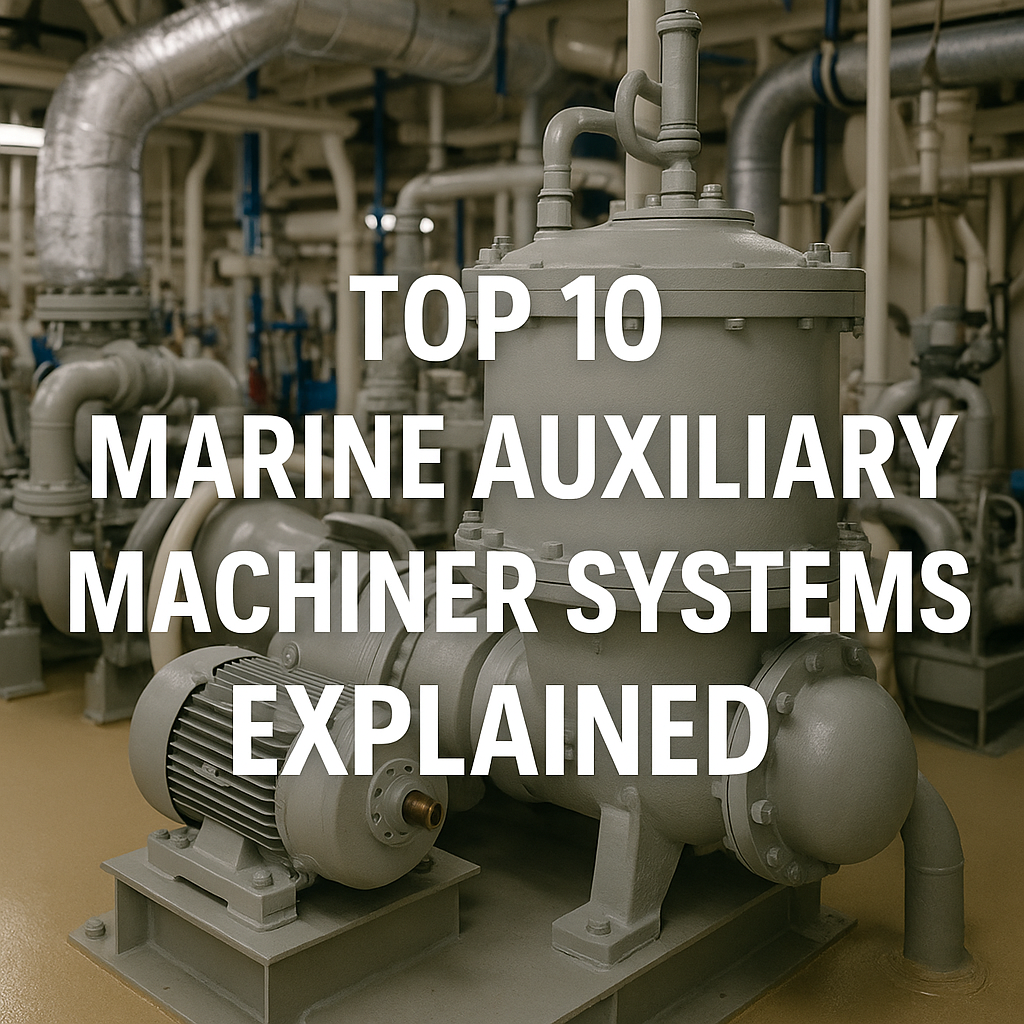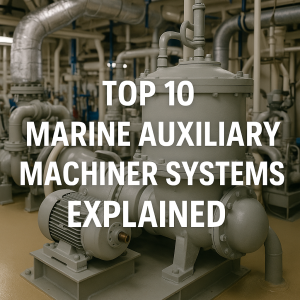Explore the top 10 marine auxiliary machinery systems that support ship operations. Learn how pumps, purifiers, compressors, and more keep vessels running safely and efficiently.
Why Marine Auxiliary Machinery Matters in Modern Maritime Operations
When people think of a ship’s engine room, they often imagine a single massive main engine powering the vessel across oceans. However, behind every successful voyage lies a complex web of support systems known as marine auxiliary machinery—the unsung heroes of ship operations.
From purifying fuel to generating electricity, these systems are crucial to maintaining propulsion, onboard safety, and environmental compliance. According to data from the International Maritime Organization (IMO) and classification societies like DNV, many ship incidents stem not from the main engine, but from auxiliary machinery failures—underscoring their critical role.
Understanding Auxiliary Machinery: The Backbone of Ship Operations
Auxiliary machinery refers to all secondary systems on a ship that support the primary engine, crew needs, and cargo operations. While the main engine provides propulsion, auxiliary systems handle everything from bilge water management to electricity generation.
Their importance is magnified on Unattended Machinery Space (UMS) ships, where system automation, redundancy, and diagnostics must be near-perfect.
Top 10 Marine Auxiliary Machinery Systems
1. Marine Pumps
Pumps are fundamental to shipboard operations. They manage:
-
Fuel transfer
-
Ballasting and deballasting
-
Bilge water removal
-
Cooling systems
-
Firefighting
Types:
- Centrifugal: High-flow, low-viscosity fluids (e.g., seawater cooling)
- Reciprocating: High-pressure needs (e.g., boiler feed)
- Screw and gear pumps: Lubricating and heavy oil services
📘 See also: IMO’s guidance on pollution prevention via bilge water handling (MARPOL Annex I).
2. Purifiers and Separators
Used to remove water, sludge, and contaminants from:
-
Fuel oil (FO)
-
Diesel oil (DO)
-
Lubricating oil (LO)
Function: Maintain optimal combustion and reduce wear on injectors, valves, and piston rings.
Modern Development: Automatic self-cleaning purifiers integrated with fuel oil monitoring systems (FOMS).
🛢 Best Practice: Centrifuge operation must match viscosity curves and preheated fuel temperature—typically ~98°C for HFO.
3. Air Compressors and Starting Air Systems
Air compressors provide:
-
Starting air for main and auxiliary engines
-
Control air for automation systems
-
Deck machinery operation (e.g., pneumatic tools, horn)
System Components:
-
Main air compressors
-
Air bottles (storage tanks ~30 bar)
-
Control air filters and dryers
🔧 Note: Starting air valve failures are a leading cause of delayed departures, especially in high-humidity ports.
4. Freshwater Generators (Evaporators or Reverse Osmosis Systems)
Ships at sea need freshwater for:
-
Crew consumption
-
Engine jacket cooling
-
Boiler feedwater
Types:
-
Evaporators (flash distillers)
-
Reverse Osmosis (RO) systems—common on modern vessels
Energy Source: Waste heat from jacket cooling water or steam lines.
💡 Advancement: Energy Recovery Devices (ERD) in RO systems now reduce fuel consumption by 30–50%.
5. Boilers and Exhaust Gas Economizers
Marine boilers supply steam for:
-
Fuel heating
-
Tank cleaning
-
Auxiliary machinery operation (e.g., cargo pumps on tankers)
Exhaust Gas Economizers (EGE) recover waste heat from main engine exhaust to generate steam efficiently.
📘 SOLAS Chapter II-1 outlines boiler safety regulations, especially for pressure vessels.
6. Sewage Treatment Plants
Required by MARPOL Annex IV, these units treat blackwater from toilets and greywater from galleys before discharge.
Technologies:
-
Biological aerobic digestion
-
Membrane bioreactors (MBR)
-
Chlorination and UV disinfection
⚠️ Regulation: Untreated discharge is prohibited within 12 nautical miles of the nearest land.
7. Oily Water Separator (OWS) and Oil Content Monitor
The OWS system separates oil from bilge water, ensuring that discharges remain below 15 ppm, as required by MARPOL Annex I.
Components:
-
Coalescers
-
Emulsion breakers
-
Oil content meters
-
Automatic stop valves
📘 Required Logs: Oil Record Book (ORB), inspected regularly during Port State Control (PSC).
8. Shaft Generators and Auxiliary Engines
Shaft generators utilize main engine rotation to generate electricity, while auxiliary engines (diesel generators) are used in:
-
Port
-
Maneuvering
-
Low-speed navigation
Load Distribution: Managed via power management systems (PMS) that auto-connect or disconnect units based on demand.
🌍 Environmental Impact: Hybrid shaft generators reduce fuel usage and NOx emissions.
9. Steering Gear Systems
Essential for course control, especially during:
-
Port approach
-
Narrow channel navigation
-
Emergency maneuvers
Types:
-
Ram-type
-
Rotary vane-type
Testing: Per SOLAS Chapter V, must be tested within 12 hours before departure.
🔍 Automation: Feedback sensors send real-time rudder position to ECDIS and autopilot systems.
10. Refrigeration and Air Conditioning Systems
Critical for:
-
Food preservation
-
Cargo cooling (reefer ships)
-
Crew comfort (especially in tropical zones)
Refrigerants:
-
R-134a (common but being phased out)
-
R-407C, R-744 (eco-friendlier options)
New Regulation: The IMO aims to phase down HFCs under the Kigali Amendment to the Montreal Protocol.
–
Real-World Insight: Auxiliary System Failure Averted
In 2022, an offshore supply vessel experienced a critical fuel contamination event mid-journey. The purifier auto-detected high water content and shut down fuel flow. Manual intervention by a 3rd engineer prevented engine stalling. Post-incident analysis showed that purifier automation and proactive alarms averted a potential blackout and emergency anchoring.
Frequently Asked Questions (FAQ)
Q1: Are all auxiliary systems required on every vessel?
A: No. The systems required depend on the ship’s type, trade route, and tonnage. However, core systems like bilge pumps, air compressors, and generators are universal.
Q2: How often are auxiliary systems inspected?
A: Daily routine checks, weekly functional tests, and periodic class surveys (annual, intermediate, and special) ensure system health.
Q3: What certification covers auxiliary machinery operation?
A: STCW (particularly Model Course 7.02 for engine watchkeeping) and Flag State-specific endorsements.
Q4: Can auxiliary system failures lead to vessel detention?
A: Yes. Port State Control can detain vessels for inoperable OWS, fire pumps, steering gear, or sewage systems.
Q5: Are newer ships using more automated auxiliary systems?
A: Absolutely. Integrated Control and Automation Systems (ICAS) now monitor and manage auxiliary equipment in real-time with less human intervention.
Conclusion: Mastering the Machinery That Keeps Ships Moving
Marine auxiliary machinery may not drive the propeller shaft, but it drives every other system vital for safe, clean, and efficient ship operation. From sustaining life onboard to supporting propulsion and compliance, these systems are indispensable.
Understanding their function, maintenance, and troubleshooting is what sets apart a competent marine engineer from a great one.
⚙️ Looking for simulation tools, system schematics, or certification prep for marine machinery? Explore MaritimEducation.com to elevate your engineering skills.
References
-
International Maritime Organization. (2024). SOLAS and MARPOL Conventions. https://www.imo.org
-
DNV. (2023). Auxiliary System Class Requirements. https://www.dnv.com
-
McGeorge, H.D. (2013). Marine Auxiliary Machinery (7th Ed.). Butterworth-Heinemann.
-
ICS. (2022). Engineering Safety and Efficiency Manual. https://www.ics-shipping.org
- Alao watch below video:


